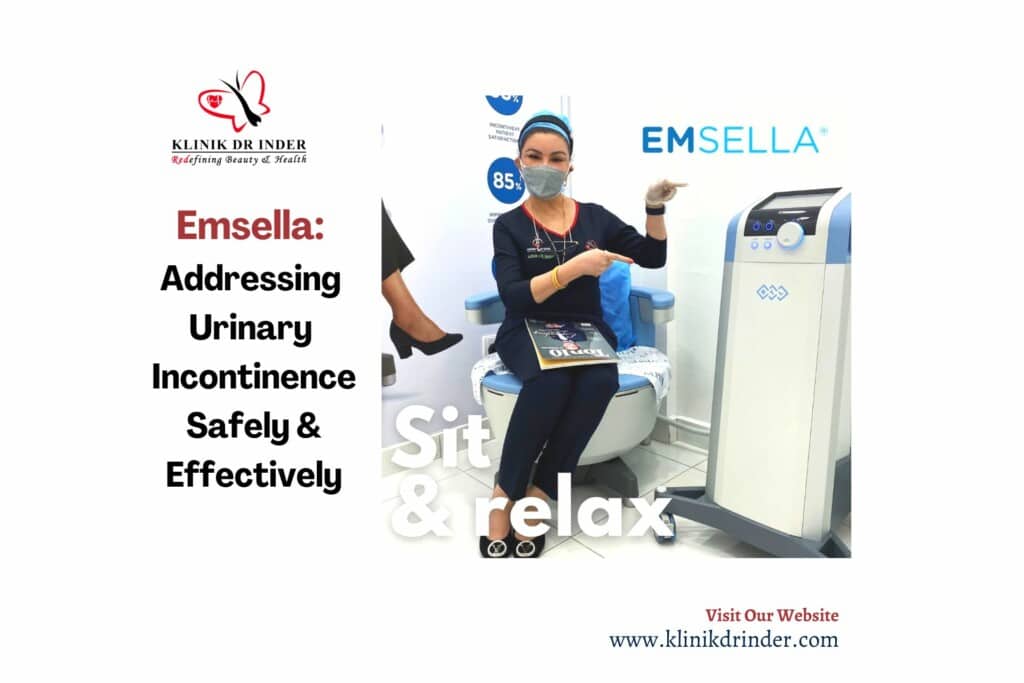Emsella: Addressing Urinary Incontinence Safely & Effectively
Urinary incontinence can be humiliating and distressing, even though it should not be. Urinary incontinence affects the majority of women at some time throughout their life, so there’s no need to be ashamed to seek help from your primary care physician. Using the Emsella chair, patients with urine incontinence can finally find relief.

Urinary incontinence comes in four main forms:
- When you cough or exercise and strain, you leak a little bit of pee, this is called stress incontinence.
- Having a sudden, strong need to urinate and being unable to go to the bathroom in time is known as “urge incontinence,” sometimes known as “an overactive bladder.”
- An overflow incontinence is a condition in which you can’t empty your bladder completely, resulting in frequent urination.
- When people talk about “mixed incontinence,” they’re referring to symptoms that include both stress and urge incontinence.
Incontinence of the Urine
Urinary incontinence has a wide range of etiologies. As a result of the stress of pregnancy or the recovery after delivery, many women develop stress incontinence and urge incontinence. A major cause of incontinence for women who do not utilise hormone replacement treatment is menopause (HRT). Medications and diseases as well as injuries to the pelvis might be factors.
Incontinence treatment
When it comes to incontinence, the options for therapy currently include pelvic floor exercises, medications, or surgical intervention. New therapy for urine incontinence, however, has been scientifically demonstrated to work, with 95% of patients reporting significant improvements.
Using supramaximal stimulation of the pelvic floor and bladder muscles, the Emsella chair is an FDA-approved incontinence therapy. Simply sitting comfortably for 30 minutes is the same as performing 11200 Kegel exercises. Users report only a slight tingling as their experience with Emsella’s therapy progresses.
Once you’ve had treatment in the Emsella chair, you may get on with your day as normal. The suggested course of therapy for all forms of urine incontinence is six weekly sessions, however some patients may benefit from more. There is a possibility that you will occasionally need a top-up treatment.
Urinary Incontinence Needs to Be Addressed Now
Even though incontinence is prevalent and affects people of any age, many people avoid discussing it out of fear of being judged. Unfortunately, this results in unnecessary suffering for those who may benefit from proper therapy. Contact your doctor if you are experiencing incontinence symptoms. Be sure to keep a bladder journal for the week leading up to your visit, noting everything you eat and drink, as well as how often you leak pee and how much it costs. An correct diagnosis will allow you to receive the most effective therapy from your doctor.
Preventing urinary incontinence can be achieved by:
- Avoiding or consuming no more than the 14-unit weekly limit suggested by the CDC.
- Giving up or reducing the amount of caffeine in one’s diet or beverages
- Reducing your weight if you’re above your ideal BMI (BMI).
- Daily pelvic floor exercises are a good idea, as well.
- The Emsella therapy is not yet accessible on the NHS at this point. If you’re going to pay for this therapy on your own, be sure the clinic you choose is medically supervised.
Would you like to know more?
Schedule A Free Consultation Now
Alternatively you can give us a call at +60379321818








